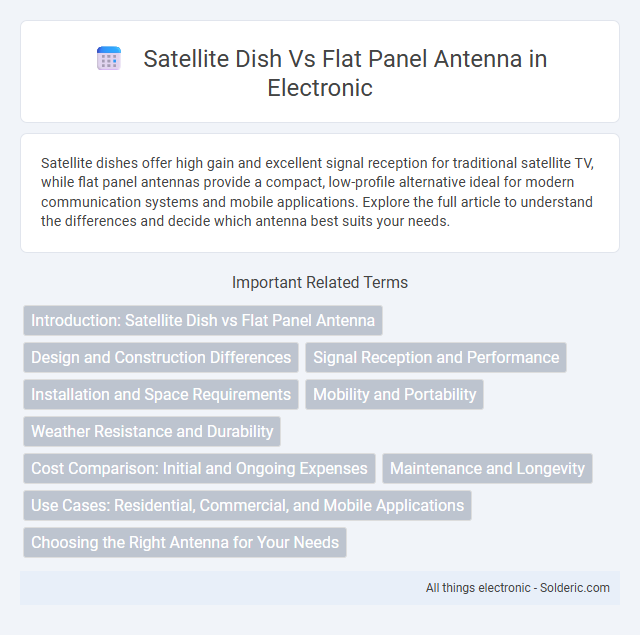Satellite dishes offer high gain and excellent signal reception for traditional satellite TV, while flat panel antennas provide a compact, low-profile alternative ideal for modern communication systems and mobile applications. Explore the full article to understand the differences and decide which antenna best suits your needs.
Comparison Table
| Feature | Satellite Dish | Flat Panel Antenna |
|---|---|---|
| Design | Parabolic reflector dish | Planar, flat surface |
| Size | Typically large (18"-36" diameter) | Compact and slim |
| Weight | Heavier due to metal dish | Lighter, often made with composite materials |
| Installation | Requires precise alignment and mounting | Easier installation, less alignment sensitive |
| Durability | Vulnerable to wind and weather damage | More durable and resistant to harsh conditions |
| Performance | High gain, focused signal reception | Moderate gain, wider beamwidth |
| Frequency Range | Commonly Ku-band, C-band | Supports Ku-band, Ka-band |
| Cost | Generally lower cost | Often higher initial cost |
| Use Case | Traditional satellite TV and data links | Mobile satellite communications, flat surface applications |
Introduction: Satellite Dish vs Flat Panel Antenna
Satellite dishes use parabolic reflectors to focus signals onto a central feed horn, providing high gain and reliable reception over long distances. Flat panel antennas employ phased array technology or planar design, offering a compact, low-profile alternative ideal for mobile and urban environments with limited space. Both technologies support satellite communication, but flat panel antennas excel in flexibility and ease of installation while satellite dishes deliver superior signal strength and range.
Design and Construction Differences
Satellite dishes feature a parabolic reflector that concentrates signals onto a central feed horn, offering high gain and precise signal focusing through their curved design. Flat panel antennas use phased array technology with multiple small elements embedded in a flat surface, enabling electronic beam steering without moving parts. Your choice depends on installation space, signal requirements, and desired durability, with satellite dishes typically larger and more sensitive to alignment compared to compact, robust flat panel antennas.
Signal Reception and Performance
Satellite dishes provide superior signal reception through a parabolic reflector that efficiently focuses signals onto a single feedhorn, enabling high gain and strong performance even in weak signal areas. Flat panel antennas utilize phased array technology to electronically steer beams and maintain consistent signal quality with a compact design, making them ideal for mobile or space-constrained applications. While satellite dishes excel in direct line-of-sight reception with minimal signal loss, flat panel antennas offer enhanced versatility and resilience in dynamic environments by adjusting beam direction without physical movement.
Installation and Space Requirements
Satellite dish installation requires a clear line of sight to the satellite and typically needs a sturdy mounting point, often on rooftops or exterior walls, occupying more space due to the dish's circular shape and depth. Flat panel antennas feature a slim, compact design that allows for easier mounting on walls or poles, making them ideal for limited space environments and simpler, quicker installation processes. The flat panel's streamlined structure minimizes wind resistance and reduces the need for heavy-duty mounting hardware compared to traditional satellite dishes.
Mobility and Portability
Satellite dishes provide stable signal reception but are bulky and less suited for mobility, often requiring precise alignment and mounting. Flat panel antennas offer superior portability and ease of installation due to their compact, lightweight design, making them ideal for mobile applications such as RVs or portable internet setups. Your choice hinges on whether you prioritize stable, long-range reception or flexible, on-the-go connectivity.
Weather Resistance and Durability
Satellite dishes typically feature robust metal construction designed to withstand harsh weather conditions such as heavy rain, snow, and strong winds, ensuring long-term durability. Flat panel antennas, often made with advanced composites and sealed electronics, offer superior resistance to environmental elements like moisture and UV radiation, making them ideal for extreme climates. Your choice between the two should consider specific weather challenges, as flat panel antennas provide enhanced protection against corrosion and physical damage compared to traditional satellite dishes.
Cost Comparison: Initial and Ongoing Expenses
Satellite dishes generally have a lower initial cost compared to flat panel antennas due to simpler manufacturing and widely available components. However, flat panel antennas can offer reduced ongoing expenses through lower maintenance requirements and enhanced durability in harsh weather conditions. Over time, the total cost of ownership may balance out as flat panel antennas improve signal strength and reduce service interruptions, potentially lowering operational costs.
Maintenance and Longevity
Satellite dishes typically require regular maintenance to ensure optimal performance, including realignment, cleaning, and occasional repairs due to their exposed curved surfaces and mechanical parts. Flat panel antennas, designed with fewer moving components and a compact, weather-resistant structure, offer enhanced durability and reduced upkeep over time. Longevity for flat panel antennas generally exceeds that of traditional satellite dishes, making them a cost-effective choice for long-term use.
Use Cases: Residential, Commercial, and Mobile Applications
Satellite dishes are commonly used in residential settings for direct-to-home television reception, offering wide coverage and reliable signal strength. Flat panel antennas excel in commercial and mobile applications due to their compact design, aerodynamic profile, and ease of integration with vehicles or portable systems. Both technologies serve diverse needs, but flat panels are preferred for mobile connectivity and limited space environments, while satellite dishes dominate static installations requiring high gain.
Choosing the Right Antenna for Your Needs
Selecting the right antenna depends on your specific requirements such as installation space, signal strength, and frequency range. Satellite dishes provide strong signal reception and are ideal for long-distance communication, especially in fixed locations, while flat panel antennas offer a compact design, easy portability, and better performance in confined spaces or on mobile platforms. Evaluating factors like signal directionality, weather resistance, and mounting options ensures optimal performance for your communication needs.
satellite dish vs flat panel antenna Infographic

 solderic.com
solderic.com